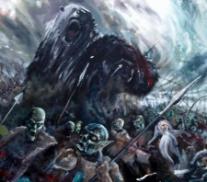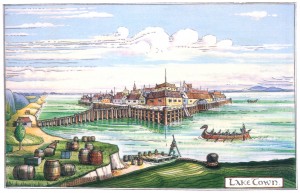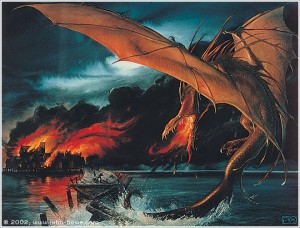 At the beginning of this month, the TORn messageboard Reading Room (home on our boards to all things Tolkien and scholarly) held an amateur symposium, with a number of folks submitting papers for discussion.
At the beginning of this month, the TORn messageboard Reading Room (home on our boards to all things Tolkien and scholarly) held an amateur symposium, with a number of folks submitting papers for discussion.
Among them them was this interesting piece by Arandir analysing the Battle of the Five Armies. We felt it was deserving of a wider audience and are delighted to — with Arandir’s permission — reproduce it for you as a TORn Library piece.
How many fought at the Battle of the Five Armies?
by TORn staffer Arandir
It is well known that in his stories, especially concerning battles, Tolkien does not give his readers much information about the size of the armies involved. This is the case with the Battle of Five Armies, as described in The Hobbit. This article shall lay out all findings regarding the battle -– focusing on the statistics, quoting passages from the text and providing speculative remarks.
There is no question that from its name, we can make out that the five armies involved are: elves, dwarves, men, goblins and wargs (but also including eagles – to which I refer later on). In The Hobbit the battle is described in the chapter ‘The Clouds Burst’ but in the previous chapters leading to it (and the one that follows after) contain some hints and information about all armies involved.
Before the battle
 Taking into consideration the fourteenth chapter from the book, ‘Fire and Water’, during Smaug’s attack on Lake-town, we are presented with the following quotes:
Taking into consideration the fourteenth chapter from the book, ‘Fire and Water’, during Smaug’s attack on Lake-town, we are presented with the following quotes:
“… every warrior was armed, every arrow and dart was ready.”
“… a hail of dark arrows leaped up and snapped and rattled on his scales and jewels …”
“… cheering on the archers” – Bard
“… there was still a company of archers.”
There is no doubt that Lake-town had some form of army as words like warrior, archers and company are clear references to such a military structure. Regarding numbers, we are not told at this point but one can only guess that since during the town’s destruction many had died or fled (but some remained to fight the Battle of the Five Armies alongside the Elves) a few hundred would have certainly been present.
After the death of Smaug, in the same chapter, we are told about the Wood Elves’ army coming to the men’s rescue.
“He [the Elvenking] had not boats or rafts enough for his host, and they were forced to go the slower way by foot.”
The word host here implies quite a large number of infantry. In fact, if one looks it up in the dictionary, it is described as: “a great multitude, a muster” – just like the mustering of Rohan at the time of the War of the Ring. It can only be assumed that in order to help the men of Lake-town, and carry the large supplies we are told of in the book, the Elvenking would have needed as many elves as he could gather.
“… all the men of arms who were still able, and the most of the Elvenking’s array, got ready to march …”
So now we know that the remaining men who had survived the attack on Lake-town and the majority of the Elf army headed towards the Mountain. Once again array is used to describe the Elven force.
Proceeding towards the next chapter, ‘The Gathering of the Clouds’, the events set in motion by the death of Smaug start to unfold and the strategies of each army will slowly be laid out as the narrative continues. At this point, Thorin and the Company are hiding on top of Ravenhill, but soon receive word of the dragon’s demise by Roäc — along with the following statement:
“… many are gathering hither beside the birds … Already a host of the elves is on the way …”

With the progression of the chapter, the dwarves find themselves captives inside Erebor as the Mountain is besieged. Yet again, we find further ambiguous references to the size of the armies:
“There came a night when suddenly there were many lights as of fires and torches away south in Dale before them […] ‘They have come!’ said Balin. ‘And their camp is very great.’”
The next chapter, ‘A Thief in the Night’, contains only one relevant quote -– it is, ironically, one out of two in all The Hobbit that gives any reference to the size of the armies. Thorin soon receives information that a dwarf host has been dispatch to aid in his struggle:
“… Dáin and more than five hundred dwarves, hurrying from the Iron Hills …”
The idea that five hundred dwarves participated in the Battle of Five Armies is something that almost every reader of the book is aware of.
But this is still unclear since it cleverly uses the words more than. How much more than that figure they could have been is impossible to state, but what is definitive is that by including Thorin, his company, Dáin and possibly dwarf scouts and other military workforce, between 525 and 550 might have been present that day of the battle.


